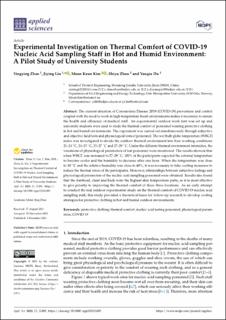| dc.contributor.author | Zhao, Yingying | |
| dc.contributor.author | Liu, Jiying | |
| dc.contributor.author | Kim, Moon Keun | |
| dc.contributor.author | Zhou, Shiyu | |
| dc.contributor.author | Du, Yanqiu | |
| dc.date.accessioned | 2022-08-05T13:35:25Z | |
| dc.date.available | 2022-08-05T13:35:25Z | |
| dc.date.created | 2021-12-08T13:15:22Z | |
| dc.date.issued | 2021-12-04 | |
| dc.identifier.issn | 2076-3417 | |
| dc.identifier.uri | https://hdl.handle.net/11250/3010401 | |
| dc.description.abstract | The current situation of Coronavirus Disease 2019 (COVID-19) prevention and control coupled with the need to work in high-temperature harsh environments makes it necessary to ensure the health and efficiency of medical staff. An experimental outdoor work tent was set up and university students were used to study the thermal comfort of personnel wearing protective clothing in hot and humid environments. The experiment was carried out simultaneously through subjective and objective field tests and physiological tests of personnel. The wet bulb globe temperature (WBGT) index was investigated to divide the outdoor thermal environment into four working conditions: 21–23 ◦C, 23–25 ◦C, 25–27 ◦C and 27–29 ◦C. Under the different thermal environment intensities, the variations of physiological parameters of test personnel were monitored. The results showed that when WBGT was increased to 27–29 ◦C, 100% of the participants expected the external temperature to become cooler and the humidity to decrease after one hour. When the temperature was close to 30 ◦C and the relative humidity was close to 60%, it was necessary to take cooling measures to reduce the thermal stress of the participants. Moreover, relationships between subjective feelings and physiological parameters of the nucleic acid sampling personnel were obtained. Results also found that the forehead, chest and back were the highest skin temperature parts, so it is most effective to give priority to improving the thermal comfort of these three locations. As an early attempt to conduct the real outdoor experimental study on the thermal comfort of COVID-19 nucleic acid sampling staff, this study provided a theoretical basis for follow-up research to develop cooling strategies for protective clothing in hot and humid outdoor environments. | en_US |
| dc.description.sponsorship | This work was funded by the Support Plan for Outstanding Youth Innovation Team in Colleges and Universities of Shandong Province (2019KJG005) and Natural Science Foundation of Shandong Province (ZR2020ME211, ZR2021ME199). | en_US |
| dc.language.iso | eng | en_US |
| dc.publisher | MDPI | en_US |
| dc.relation.ispartofseries | Applied Sciences;Volume 11 / Issue 23 | |
| dc.rights | Navngivelse 4.0 Internasjonal | * |
| dc.rights.uri | http://creativecommons.org/licenses/by/4.0/deed.no | * |
| dc.subject | Protective clothing | en_US |
| dc.subject | Thermal comfort | en_US |
| dc.subject | Nucleic acid testing personnel | en_US |
| dc.subject | Physiological parameters | en_US |
| dc.subject | COVID-19 | en_US |
| dc.title | Experimental Investigation on Thermal Comfort of COVID-19 Nucleic Acid Sampling Staff in Hot and Humid Environment: A Pilot Study of University Students | en_US |
| dc.type | Peer reviewed | en_US |
| dc.type | Journal article | en_US |
| dc.description.version | publishedVersion | en_US |
| dc.rights.holder | © 2021 by the authors | en_US |
| dc.source.articlenumber | 11492 | en_US |
| cristin.ispublished | true | |
| cristin.fulltext | original | |
| cristin.qualitycode | 1 | |
| dc.identifier.doi | https://doi.org/10.3390/app112311492 | |
| dc.identifier.cristin | 1966217 | |
| dc.source.journal | Applied Sciences | en_US |
| dc.source.volume | 11 | en_US |
| dc.source.issue | 23 | en_US |
| dc.source.pagenumber | 1-19 | en_US |
| dc.relation.project | Support Plan for Outstanding Youth Innovation Team in Colleges and Universities of Shandong Province: 2019KJG005 | en_US |
| dc.relation.project | Natural Science Foundation of Shandong Province: ZR2020ME211 | en_US |
| dc.relation.project | Natural Science Foundation of Shandong Province: ZR2021ME199 | en_US |

